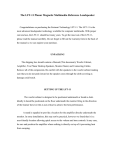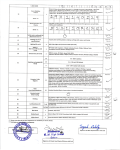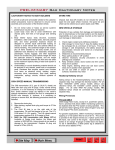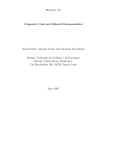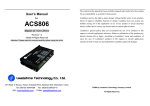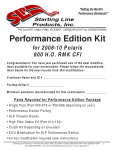Download Introduction to ProTuner for the ACS606
Transcript
Introduction to ProTuner for the ACS606 Main Window Menu and Toolbar File Open Open a configuration file from disk. Note: The parameters will download to the drive automatically. Save Save the configuration to a file. Save as Save the configuration to as another file. Exit Exit the ProTuner. Drive Connect to drive Click to open the communication setup window. Then select the right serial port connected to the ACS606 and click the Open button. Current Loop Click to open the Current Loop Tuning window. Tune the Kp (Proportional Gain) and Ki (Integral Gain) of driver’s current loop to optimize responses with different motors. Start/Restart a Step Response test to get an optimum response. Kp: Current loop Proportional Gain Proportional Gain determines the response of the driver to current setting command. Low Proportional Gain provides a stable system (doesn’t oscillate), has low stiffness, and large current error, causing poor performances in tracking current setting command in each step. Too large Proportional Gain values will cause oscillations and unstable systems. Ki: Current loop Integral Gain Integral Gain helps the driver to overcome static current errors. A low or zero value for the Integral Gain may have current errors at rest. Increasing the Integral Gain can reduce the error. If the Integral Gain is too large, the systems may “hunt” (oscillate) about the desired position. Step It is the command value for the step test. Setting range is 0.5-6A. Start Click to start a Step Response test. Position Loop Click to open the position loop tuning window which includes four tabs: Parameter, Internal Pulser, Scope Setting and Signal Setting. The user can tune the PID (Proportional Gain, Integral Gain and Derivative Gain) of the position loop and get the visual result from the scope. The related parameters for the position mode control can also be configured in this window. Parameter tab Kp: Position Loop Proportional Gain Proportional Gain determines the response of the system to position errors. Low Proportional Gain provides a stable system (doesn’t oscillate), has low stiffness, and large position errors under load. Too large Proportional Gain values will cause oscillations and unstable systems. Ki: Position Loop Integral Gain Integral Gain helps the control system overcome static position errors caused by friction or loading. The integrator increases the output value as a function of the position error summation over time. A low or zero value for the Integral Gain may have position errors at rest (that depend on the static or frictional loads and the Proportional Gain). Increasing the Integral Gain can reduce these errors. If the Integral Gain is too large, the systems may “hunt” (oscillate at low frequency) about the desired position. Kd: Position Loop Derivative Gain Derivative Gain provides damping by adjusting the output value as a function of the rate of change of error. A low value provides very little damping, which may cause overshoot after a step change in position. Large values have slower step response but may allow higher Proportional Gain to be used without oscillation. Motor Pole Pairs Set number of pole pairs of the servo motor according to motor datasheet (For Leadshine BLM series DC brushless servo motor, it is 2; For Leadshine ACM series AC servo motor, it is 4.) CAM numerator: Numerator of the electronic gear It can be set from 1-255. CAM denominator: Denominator of the electronic gear It can be set from 1-255. The actual motor speed can be calculated as the following formula: Velociy ( rpm ) = ( Pulse Input Frequence ) × 60 ( Encoder Line Count ) × 4 CAM Numerator × CAM Denominato r Following Error Limit Set the limit of the difference between commanded position and the actual measured position. When position following error reaches Position Following Error Limit parameter setting in the driver, the protection will be activated. Encoder Resolution The Encoder Lines parameter here is just for self-test motion controller during tuning, and will not affect the driver to interpret the encoder feedback signal. With regard to the ACS606, feedback resolution is ×4 encoder line count. Start/Stop The user can start or stop self-test by clicking this button. Internal Pulser tab The user can set velocity profile for self motion test and tuning, including Velocity, Acceleration, position move Distance of trapezoidal velocity profile, and Interval, Repeat Times of self motion test. Velocity Set the maximum velocity of the trapezoid velocity profile. Its unit is RPM. Acceleration Set the acceleration of trapezoidal velocity profile. Its unit is r/s2. Distance: Move Distance Set the distance required to move. Its unit is pulses (counts). Interval Set the interval between positive rotation and negative rotation. Its unit is ms. Repeat Times Set the repeat times of positive rotation and negative movement. Start/Stop The user can start or stop self-test by clicking this button. Scope Setting tab The user can choose signals displayed in the scope of this window and set their Trace Time. These signals include actual measured current, actual measured velocity, command position, actually measured position and position Following Error. Measured Current: Actual Measure Current Click to display the actual measured current of the motor coil in the scope. Measured Velocity: Actual Measure Velocity Click to display the actual measured velocity of the rotation in the scope. Position Following Error Click to display the position following error of the rotation in the scope. It is the difference between the command position and the actual measured position. Command Position Click to display the command position in the scope. Measured Position Click to display the actual measured position in the scope. Start/Stop The user can start or stop self-test by clicking this button. Signal Setting tab The user can configure the direction logic, the active edge and the type of the command signal. Direction Logic Define the rotation direction when the direction input is high level. Note: The actual direction is also related to the motor connection. Positive: The rotation direction is positive when the direction input is high level. Please note that the actual direction is also related to the motor connection. Negative: The rotation direction is negative when the direction input is high level. Please note that the actual direction is also related to the motor connection Pulse Active Edge Set the triggered edge of pulse command signal. Rising: The motor moves one full step or micro step when the pulse level changed from LOW to HIGH. Falling: The motor moves one full step or micro step when the pulse level changed from HIGH to LOW. Command Type Command Mode Rotate Direction Clock Wise Counter Clock Wise Pulse & DIR CW/CCW Note: 1. The actual rotation direction is also related to the motor connection. 2. The ACS606 does not support the CW/CCW command mode. Download To Drive Download the current configurations to the ACS606. Reset Drive Restore the default configuration from the default file. Both the RAM and EEPROM of the ACS606 will be reset to the default factory configuration. Tool Scope This window displays the required signals in real time. Measured Current: Actual Measure Current Click to display the actual measured current of the motor coil in the scope. Measured Velocity: Actual Measure Velocity Click to display the actual measured velocity of the rotation in the scope. Position Following Error Click to display the position following error of the rotation in the scope. It is the difference between the command position and the actual measured position. Start/Stop Start/Stop to display the required signal. Error Tracing This window shows both the present status of each error event and their history. Over Current: Over-current Protection. Protection will be activated when continuous current exceeds the limit. Over Voltage: Over-voltage Protection. When power supply voltage exceeds 63±1.5 VDC, protection will be activated. Low Voltage: Under-voltage Protection. When power supply voltage is lower than 16.5±1.5 VDC, protection will be activated. Phase Error: Phase Error Protection. Motor power lines wrong & not connected and encoder feedback signals A/B phases wrong connected will activate this protection. Encoder Error: Encoder Error Protection. No feedback signals or wrong encoder/hall sensor feedback signals will activate this protection. Following Error: Position Following Error Limit Protection. When position following error reaches Position Following Error Limit parameter setting in the driver, this protection will be activated. Error Counter It is used to display current error(s) and current error history. Clear Current Error The user can clear current error(s) by clicking this button. Clear all The user can clear all error(s) including error history by clicking this button. Help User Manual Click to open the user manual. About Click to view the ProTuner information. Tuning Example Current Loop Tuning Example Below is an example to show the tuning procedure of current loop based on Leadshine BLM57130-1000. Power Supply: 24VDC Motor Specification: 0.57Nm@3000RPM, Phase resistance=0.63Ohm Phase Inductance=1.55mH, Encoder Lines = 1000 Step 1: See figure 3-1. Set test Step 1 Amp and begin the tuning with small Kp and zero Ki. Here we give Kp 4000. Please hit the “Enter” key after entering in the number. Figure 3-1: Initial value for Kp, Ki and Step for current loop tuning Step 2: Click the Start button and the plot window will show two curves. The red one is target current and the green one is actual measured current. There is large gap between them in the scope. It indicates that a large Kp need to be introduced. See figure 3-2. Figure 3-2: Current loop tuning with Kp=4000, Ki=0 Step 3: Increase Kp to 6000 and click Start. The gap between target value and actual value is smaller but a higher Kp is needed. See figure 3-3. Figure3-3: Current loop tuning with with Kp=6000, Ki=0 Step 4: Give Kp 7000, 9000, 12000, 15000 and click Start, respectively. The green curve is getting more and more close to the red curve. See figure 3-4. ↑Kp=7000, Ki=0 ↑Kp=9000, Ki=0 ↑Kp=12000, Ki=0 ↑Kp=15000, Ki=0 Figure3-4: Current loop tuning with with Ki=0 and increasing Kp Step 5: Now Kp is relative good enough. But there is still gap between the green curve and the red curve when we use the mouse to zoom in it as shown in figure 3-5. There is also big vibration, which will cause motor noise, on the green curve. So we need to introduce Ki, the integral gain to reduce the “gap” or steady error at the constant part. It follows the same procedure as Kp. Too high Ki will causes big vibration, system lag and makes the performance worse. See figure 3-6 for this procedure. Increase Ki until the gap can be accepted and not causes much vibration. Figure3-5: Drag a rectangle to zoom in the steady error Kp=15000, ↑Ki=100 Kp=15000, ↑Ki=200 Kp=15000, ↑Ki=300 Kp=15000, ↑Ki=400 Figure3-6: Current loop tuning with Kp=15000 and increasing Ki Step 6: The current loop tuning is basically finished. You can continue to adjust Kp and Ki for better performance. Now the updated Kp and Ki is just stored in the driver’s RAM. They will be lost when we power off the ACS606. Please click Drive->Download To Drive to store the changed value to the driver’s EEPROM. Position Loop Tuning Example This example is using the Leadshine BLM57130-1000 with no load. Power Supply: 24VDC Motor Specification: 0.57Nm@3000RPM, Phase resistance=0.63Ohm Phase Inductance=1.55mH, Encoder Lines = 1000 Before tuning the position loop parameters Kp, Kp, Kd as shown in figure 3-7, set self-test motion parameter in the Internal Pulser tab and select the measured velocity, position following error in the Scope Setting tab as figure 3-8. Trace Time affects the display length of the curve. Here we select 700ms. Velociy = 1000 rpm Acceleration = 250 r/s/s Distance = 30000 pulses Inernal = 80 ms Repeat Times= 1 Figure3-7: Internal Pulser Settings for the tuning example Figure 3-8: Scope settings for the tuning Our purpose is to get the highest system stiffness but lowest motor noise. However, sometimes we need to trade off because high loop gain leads to big overshoot even vibration. In this example, we start with small loop gain and then back off, at the time when the motor noise begins. The tuning procedure is shown as follows: ① Set small Kp, Kd and let Ki = 0 ; ② Increase Kp and Kd synchronously for smaller position following error. Stop and back off when motor noise/vibration begins; ③ Increase Ki a bit for smaller steady error ; ④ Save changed to the drive by clicking Drive->Download to drive. Step 1: Set Kp = 1000, Ki = 0, Kd = 1000 Encoder line = 4000. Please hit the “Enter” key in the keyboard every time you change the parameters. The initial value for the tuning is depending on supply voltage, motor and reflected load inertia. The above settings may not suitable for your system. Please adjust them according to different result as follows: Decrease Vp/Kp if the motor generates big noise. Increase Vp/Kp if the drive’s red LED blinks (Protection Mode). Figure 3-10 shows the velocity (The green curve) and position following error (The blue curve). The position following error is 165 for the initial Kp=Kd=1000, Ki=0. Tip: Giving an external torque by rotating the motor shaft (or moving the load) manually is good way to check whether the Kp and Kd are suitable or not. If the shaft is hard to rotate/move and the motor generates big noise, you should decrease Kp and Kd. If it is easy to rotate/move the shaft and the drive goes into protection mode (the red LED blinks), you should increase Kp and Kd. Figure 3-9: Observe the motor noise/vibration when increasing loop gain Step 2: Increase Kp and Kd synchronously until motor noise/vibration begins. Then back off. To activate the noise/vibration, sometimes you need to give a disturbance to the load by either starting the self-motion test or trying to push/pull the load. In this example, we give both Kp and Kd 2000, 3000, 4000, 5000 and 6000. We find that the noise/vibration begins at Kp=Kd=6000. So we stop increasing Kp and Kd. The motor shaft or load is stiff enough at standstill when we back off Kp to 5000 and the motor noise/vibration can be accepted. And we can see the position following error is reduced when the Kp and Kd increase. See figure 3-11, 12, 13 and 14. Tip: The scope displays actual measured velocity (the green curve) and position following error (The blue curve) as shown in figure 6-28. It is the result of the trapezoidal velocity test after clicking Start button. Click the button once again to hold on the curves (The button caption is “Start”). Otherwise the scope will be updated (The button caption is “Stop”). The user can put the mouse (cursor) on the curve to check the curve point value at the top status bar. Kp = Kd = 1000, Ki = 0 Position Following Error (Acceleration) = 165 Figure 3-10: Scope fro Position/Velocity Loop Tuning Kp = Kd = 2000, Ki = 0 Position Following Error (Acceleration) = 72 Figure 3-11: Increase Kp to 2000 to maximize the system stiffness Kp = Kd = 3000, Ki = 0 Position Following Error (Acceleration) = 46 Figure 3-12: Increase Kp to 3000 to maximize the system stiffness Kp = Kd = 4000, Ki = 0 Position Following Error (Acceleration) = 35 Figure 3-13: Increase Kp to 4000 to maximize the system stiffness Kp = Kd = 5000, Ki = 0 Position Following Error (Acceleration) = 27 Figure 3-14: Increase Kp to 5000 to maximize the system stiffness Step 3: Now the system has been basically tuned. But there is still large position error during constant velocity. See figure 3-15. We can increase the integral gain Ki a bit to reduce the error. See figure 3-16, 17 and 19 for this procedure. Please note that too large Ki will lead to bad result. Kp = Kd = 5000, Ki = 0 Position Following Error (Constant Velocity) = 8 Figure 3-15: Large Position Following Error when Ki = 0 Kp = Kd = 5000, Ki =100 Position Following Error (Constant Velocity) = 6 Figure 3-16: Increase Ki to 100 for Smaller Position Error Kp = Kd = 5000, Ki =200 Position Following Error (Constant Velocity) = 4 Figure 3-17: Increase Ki to 200 for Smaller Position Error Kp = Kd = 5000, Ki =300 Position Following Error (Constant Velocity) = 2 Figure 3-18: Increase Ki to 300 for Smaller Position Error Step 4: The tuning is finished. You can adjust the Kp, Kd and Ki if necessary. The Kd has not be the same as the Kp but the difference should be large. After that, the last thing is save all the changed to the drive. Please select Drive->Download to Drive in the menu bar. Tip: Remember that tuning the servo is to get satisfying performances, getting the best performances of the servo is a time consuming work. So if the servo performance can meet your application requirements, then the easier tuning way the better. Just like if the performances of the products can meet your application requirements, then the cheaper the better.























